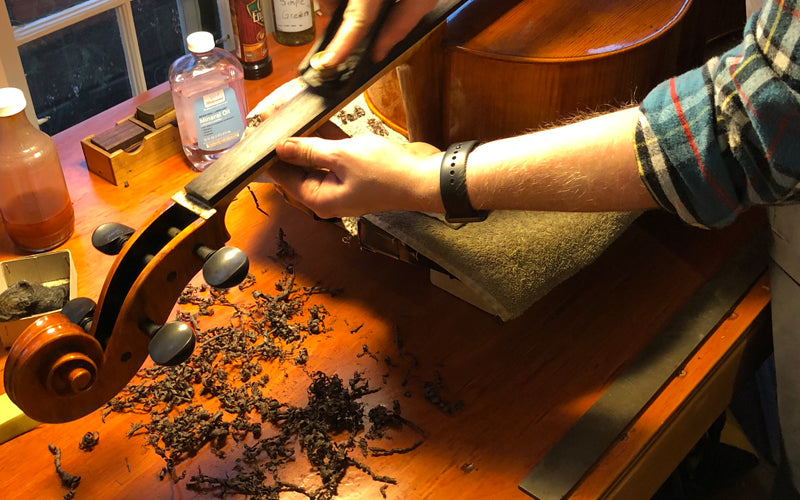How to Pack a Cello
We have put together a step by step guide for packing your cello, whether for a rental return, upgrade, or your own travel.

| 1. Begin by wrapping foam or paper towel around the bridge, and secure it with tape. This will prevent the top from being scratched or damaged should the bridge come down in transit. | |
|
|
|
|
3. Next, put the instrument in the case or bag. Be sure there is no movement of the instrument within the case (side to side or top/scroll to bottom). Foam sheets or other soft cloths can be used to fill in any open space; take great care with this step. If a bow is also being sent, DO NOT put the bow in the case using velcro/snap/spinners (wrap in foam/plastic and place right on top of the case among the peanuts. |
|
|
4. Make sure 3-4 layers of bubble wrap strips are centered on the bottom of the box before placing the bag/case on top of the bubble wrap. Tape corner post reinforcement to corner where scroll end of the cello will be |
 |
| 5. Place folded bubble wrap at top/bottom/sides to ensure no case contact with the box. Again, there should be very little movement of the case in any direction - if you can hear or see much movement, add another layer of bubblewrap or thinner styrofoam. | |
 |
|
| 6. Fill the entire box with packing peanuts, shaking gently to settle a few times. Be sure the closing sides of box do not "give in" when pressing gently on the peanuts. If they seem to compress too easily, add a few handfuls of peanuts or other packing material. Do not overfill the box- the box/flaps should not “bulge” when closed, either |  |
| 7. Lastly, place one strip of bubble wrap on top of the peanuts, then a long, flat piece of cardboard on top. This will absorb and disperse potential impacts from above, so they do not press on the bridge. |  |
| 8. Seal the box using a strong packing or strapping tape, pressing the sides/top together snugly so there is very little gap at the middle seam. Look to ensure the box is not contorted; the edges should line up evenly with the sides of the box, or you may need to gently pull the box corners to align properly |  |
| 9. Use extra tape on the sides of the box, if the top does not seem flush with the box. |  |
Special Considerations for Different Cello Types
Student Cellos
While student cellos may be more affordable, they still deserve careful packing. Use the same techniques outlined above to ensure your instrument arrives ready to play.
Intermediate and Professional Cellos
Higher-value instruments like our intermediate and professional cellos warrant extra attention to detail. Consider double-boxing or professional packing services for these investments.
Fractional Size Cellos
Smaller fractional cellos may require adjusted packing techniques. Ensure your box size is appropriate and add extra padding to prevent movement in oversized containers.
Frequently Asked Questions About Cello Packing
Can I ship my cello bow in the case?
No, we strongly recommend removing the bow from the case and packing it separately with foam protection. This prevents the bow from damaging the instrument during transit. Consider our professional cello bows if you need a replacement or upgrade.
What if my cello case doesn't fit properly?
A properly fitted case is essential for safe shipping. If your current case allows too much movement, consider investing in a better-fitting cello case before shipping. The investment in proper protection far outweighs potential repair costs.
How do I know if my packing job is adequate?
Your packed cello should have minimal movement in any direction. Gently shake the box - you should hear almost no movement. If you hear significant rattling or shifting, add more padding material.
What about humidity control during shipping?
Extreme humidity changes can damage cellos. If shipping during very dry or humid conditions, consider adding humidity control packets to your case before packing.
Professional Setup After Shipping
Even with perfect packing, shipping can affect your cello's setup. Consider our StringWorks Setup™ service to ensure optimal performance after any shipping experience. Our skilled luthiers can:
- Verify proper bridge position and adjustment
- Check soundpost placement for optimal tone
- Assess and adjust string tension and seating
- Ensure fingerboard and nut are properly aligned
- Verify that fine tuners function correctly
Protect Your Investment
Your cello represents a significant investment in your musical journey. Whether you're playing a student instrument or a professional concert cello, proper packing ensures that investment is protected during shipping.
Remember that even minor shipping damage can affect your instrument's sound quality and playability. Taking the time to pack properly now can save you from costly repairs and frustration later.
Need Help or Have Questions?
If you have any questions about packing your cello or need guidance specific to your situation, don't hesitate to contact our expert team. We're here to help protect your instrument and ensure your musical journey continues smoothly.
For more information about our instruments, services, or policies, visit our StringWorks blog or call us at 888-624-6114. We're committed to supporting musicians at every stage of their journey with expert advice, quality instruments, and exceptional service.
Ready to Ship with Confidence?
Follow this guide for professional-level packing results. If you're shipping for a StringWorks trade-in or rental return, we appreciate your careful attention to these packing guidelines.
Contact us if you need any clarification on these instructions or have specific questions about your shipment.



